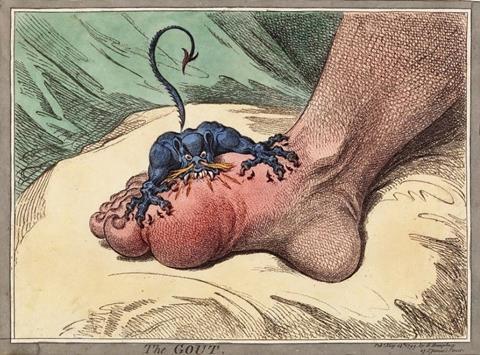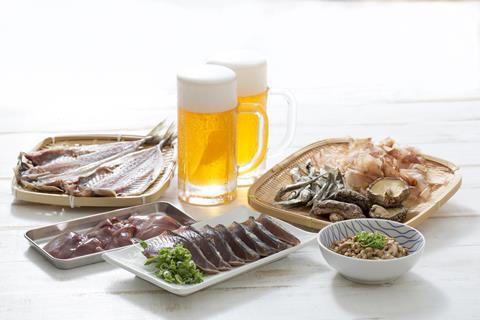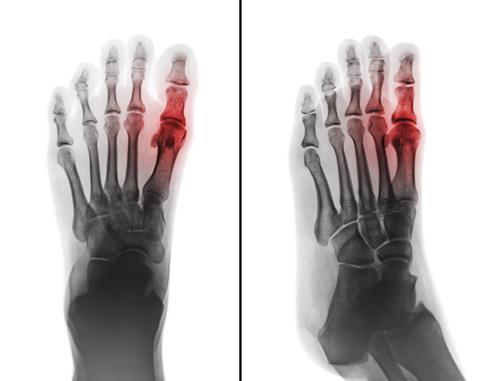Ben Valsler
This week, Michael Freemantle introduces one of the compounds he always keeps close by…
Michael Freemantle
Over the past few years, I’ve read a number of newspaper and magazine articles about gout. They often include a statement such as: ‘around half a million people in Britain suffer from gout.’ Some reports put the figure as high as one million. Well, I am one of those people.
Actually, I don’t suffer from it all the time. I get it perhaps once or twice a year. But when it does occur, it can be excruciatingly painful. And worst of all, it can strike without warning, sometimes in the middle of the night. It often hits the base of one of my big toes, or less frequently a knee, ankle or elbow. The affected joint then becomes swollen, red and hot.

Gout is one of the commonest and oldest known forms of arthritis. Its incidence throughout the world has been rising over recent decades, especially in developed countries. And it is much more common in men than women.
The disease is caused by abnormally high concentrations of uric acid in the blood, often owing to the excessive consumption of foods that are rich in purines. Furthermore, some drinks have been shown to increase uric acid levels in the body. One report I read suggests that, if you are prone to gout, you should avoid the following foods: particular vegetables such asparagus and cauliflower, seafoods like herring or scallops, red meat, turkey, liver and other organ meats, beer, and sugary drinks.
Uric acid produced by these foods in the body is normally excreted in urine. But in the case of gout, some of it converts to monosodium urate monohydrate. Needle-like crystals of the salt then deposit in a joint resulting in inflammation.

Fortunately, there are a variety of drugs that can tackle gout attacks and alleviate the pain. I have tried several in the past, including a compound known as colchicine. This prescription drug is extracted from the autumn crocus, a flowering plant also known as meadow saffron. It is an alkaloid – a type of nitrogen-containing organic compound with a complicated structure that occurs naturally in plants. Colchicine has been used to treat gout for centuries.
However, the most effective treatment, for me at least, is another prescription drug known as indometacin. It is an NSAID, that is a nonsteroidal anti-inflammatory drug. Indometacin is another nitrogen-containing organic compound but, unlike colchicine, it does not occur naturally. Synthesis of the compound was first reported in February 1963 in the Journal of the American Chemical Society by a team of scientists in the United States.
In a paper published in the October issue of the British Medical Journal the same year, two rheumatologists at the Westminster Hospital in London provided proof that indometacin has anti-inflammatory and pain-relieving effects in gout and rheumatoid arthritis. They noted that 11 out of 15 patients treated with the drug experienced a dramatic and rapid response with full symptomatic relief.

The drug, like other NSAIDs, works by inhibiting enzymes that participate in the production of prostaglandins. These are hormone-like substances that occur in a wide variety of tissues and body fluids. They dilate blood vessels and can cause inflammation and pain.
Indometacin is used to treat not only gout but also other forms of arthritis such as osteoarthritis. It is also used to tackle muscle, bone, ligament or tendon disorders and to alleviate pain and reduce swelling after bone or joint surgery. The drug, like all other medicines, can cause side effects, notably peptic ulcers.
Over the years, I have learnt that it is always important to have a packet of indometacin capsules available in my medicine cabinet and to carry a packet with me when I travel. As soon as I notice the symptoms of gout, I start taking the drug in the doses recommended by my doctor, and continue until the symptoms disappear.
Better still is not to get gout at all and to take every precaution to prevent it. Most of the time, I achieve this by avoiding purine rich foods or eating them only sparingly. But occasionally, especially when I’m on holiday or during festive occasions, I fail miserably. I then reach for my precious packet of indometacin capsules.
Ben Valsler
That was Mike Freemantle on indometacin, and how it keeps his gout under control. Next week, the surprising link between potty training and festive fake snow…
Kat Arney
By the 1970s manufacturers were quick to spot uses for these super-sucking polymers. Disposable nappies came in the early 80s, followed by absorbent pads and baffles for industrial spills, and even absorbent suits for busy NASA astronauts unable to pop to the loo.
Ben Valsler
Join Kat Arney to discover the huge range of uses for super-absorbant polymers. Visit Chemistryworld.com for more of the latest news, reviews, features and opinions from across the chemical sciences, and if you hurry you can take advantage of our summer special offer – 25% off a full year’s digital subscription – that’s only available until August 13th. And as usual you can get in touch if you like – email chemistryworld@rsc.org or tweet @chemistryworld. Thanks for joining me, I’m Ben Valsler.













No comments yet